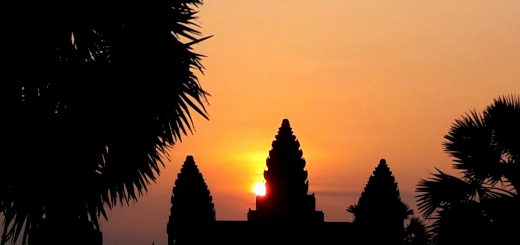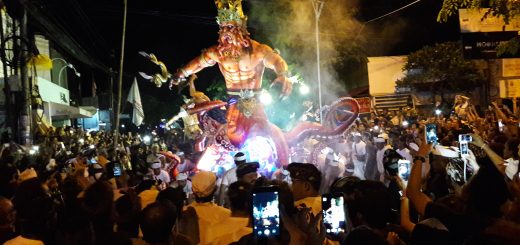Geishas and Temples and Shrines, Oh My! – A Look at Kyoto
Our second stop in our exploration of Japan would be in the well-known city of Kyoto. Kyoto served as the imperial capital of Japan for over a thousand years. Now, it is home to numerous classical Buddhist temples, as well as gardens, imperial palaces, Shinto shrines and traditional wooden houses. It boasts seventeen world heritage sites and the Gion district, the most famous place to find a geisha.
What We Did
Day 176 (1/14/17): Awaking early with a massive hangover, we packed our bags and boarded a super high-speed train headed for Kyoto. Once we arrived, we navigated our way to our apartment in the city center, dropped off our luggage and went out in search of food. We found an amazing Ramen shop not too far from our apartment and dug in to steaming hot bowls of deliciousness. After filling our bellies, we went to see the Nijo Palace, not far from our place. We spent a couple hours touring the grounds and the interior of the palace, marveling at the simplistic design, unique architecture, and amazing zen feel of the palace. It was snowing relatively hard for most of the day, and the freezing temperatures kept us from lingering too long outdoors. I was fairly tired, so we headed back to the apartment to watch Mulan and take a quick nap. For dinner, we went out to the grocery store around the corner and bought a variety of Japanese pre-packaged dinners. Then we returned to our apartment to relax and plan for our next two days in Kyoto.
Day 177 (1/15/17): We awoke today with grand plans of sight-seeing in Kyoto. However, in the morning we found that a huge storm had rolled through and deposited about six inches of snow on the ground (and it kept going), making our journey around much more difficult. Not to be deterred for long though, we bundled up and headed out into it, set on seeing the sites. Our first stop was a visit to Fushimi Inari-taisha, known for its beautiful paths, covered with bright orange gates. We initially had to fight some crowds, as this is a very well-known and popular attraction in Kyoto. However, as we kept climbing up the mountain the crowds got fewer and we could enjoy the peacefulness that this shrine was meant to inspire. We hiked to the peak and back down, enjoying the contrast between the vivid orange of the gates and the stark white color of the snow that had blanketed the forest. Afterwards, we caught a bus to see Kiyomuzu-dera Temple. This Buddhist Temple was built at the base of Mount Otowa and featured a massive main hall, four tier pagoda, various walking trails and shrines, and beautiful views of both Kyoto city and the mountain. After visiting the site, we caught yet another bus and made a quick stop to see the Heian Shrine and then the grounds of the To-ji Temple (we opted not to go in because it was more expensive). Then, we headed back to the apartment to thaw out, passing through the city’s main market on the way. We stopped and picked up supplies to make spaghetti for dinner before heading back to our apartment to eat and delve into the latest totally rad 90s power hour.
Day 178 (1/16/17): We got ready earlier today and headed out to see the bamboo grove of Arashiyama. We wandered through the snow-covered trails, surrounded by its dense, lush vegetation. Once we found our way out we wandered over to the entrance of Kyoto’s monkey park, but found it to be closed on account of all the snow Kyoto had gotten yesterday. A little bit disappointed, we made our way to the Kinkaku-ji Temple, known for its three-story golden pavilion. We took about a million photos of the temple, with its picturesque tree-lined pond in the foreground, before strolling through the rest of the grounds and sampling sweets and nuts from the vendors near the exit. Deciding that we had seen a good share of the many temples and shrines offered by Kyoto, we decided it was time to check out the city’s main market and shopping district, Nishiki. We spent a couple hours ambling through the market’s alleyways, sampling sweets, spices, and every kind of fermented and pickled vegetable you can imagine. I purchased a funahashiya (traditional rice cracker), and tuna sashimi and Adam bought some curried rice chips before we stopped to eat at a steak place called Red Rock. We finished up at the market, stopped at the grocery to pick up stuff for dinner, and spent the rest of the evening thawing out and watching movies, resting up for our trip to Hiroshima the next morning.
What We Learned
- Japan is cold in the winter. I know this sounds like a dumb thing to say, but I guess I never really thought much about it before we arrived. I found myself, on more than one occasion, wearing just about everything I owned when we went out to keep myself warm. We really got a taste of it in Kyoto, where we got hit with a big snow storm that deposited about six inches of snow on the ground overnight and made sightseeing much more difficult. So keep that in mind when planning your own travels and prepare accordingly.
- The 7/11 and Family Mart are cheap and awesome places to get lunch or dinner, and are heavily frequented by Japanese people. These convenience stores serve hot and cold pre-made food items that seem to be staples in lots of busy Japanese people’s diets. Now as a tourist, I recommend going and trying it out, as we did several times, but be aware that nothing will be in English and like I said earlier, sometimes you are just going to have to pick something and give it a try (especially with anything deep fried).
- You need to try furikake immediately. While walking past the bunches of little shops near the bamboo grove in Kyoto, we found a spot selling a spice blend called furikake. The woman there told me it is a traditional Japanese condiment to be sprinkled over rice or noodles. One bite and I was in love. I purchased the spicier variety, but all have a deep umami flavor and are composed of some combination of sesame seeds, chopped seaweed, salt, powdered miso, soy, shiso, freeze-dried veggies, egg, and powdered fish or bonito flakes. It sounds a bit strange but the flavor is unbelievable. Although it is traditionally just used for rice or noodles, I tried it on eggs for breakfast and loved it. I can’t wait to put some on fish and also try a traditional use of it over steamed rice mixed with an over-easy egg. You can always find it at Asian grocers in the U.S. and it is gaining popularity, so you may see it in your local store sooner than you think, especially on the west coast.
Memorable Moments
- Our walk through the orange gates of Fushimi Inari-taisha was an unforgettable and inspiring experience. While it was crowded in the lower levels of the mountain, once you began to hike towards the summit, the crowd thinned and you could find yourself utterly alone with the peaceful silence of the mountain and forest around you. Winter, although cold, I found to be a truly magical time to visit as the contrast between the gates and the pure white snow was utterly stunning. It is worth the effort to go all the way to the top just to experience the calm of the summit and marvel at the shrine, filled with the prayers of those who made the trek.
- When we arrived at the Kiyomuzu-dera Temple, we were shocked by the number of girls there in full, formal kimono dress. We later discovered that this was because it was the “Coming of Age” celebration in Japan. The girls in dress, were celebrating their transition into adulthood and were visiting the various shrines to make their prayers for the next stage of their life. Seeing the variety of colors, patterns, and hairstyles in the girls’ looks was truly breathtaking, and gave us a really unique look into traditional Japanese culture and dress.
Pictures

![20170114_120350[1]](http://temporarynomads.com/wp-content/uploads/2017/01/20170114_1203501-1024x768.jpg)
![20170114_120428[1]](http://temporarynomads.com/wp-content/uploads/2017/01/20170114_1204281-768x1024.jpg)
![20170114_131709[1]](http://temporarynomads.com/wp-content/uploads/2017/01/20170114_1317091-1024x768.jpg)
![20170114_131729[1]](http://temporarynomads.com/wp-content/uploads/2017/01/20170114_1317291-1024x768.jpg)
![20170114_134727[1]](http://temporarynomads.com/wp-content/uploads/2017/01/20170114_1347271-1024x768.jpg)
![20170114_135350[1]](http://temporarynomads.com/wp-content/uploads/2017/01/20170114_1353501-1024x768.jpg)
![20170115_102538[1]](http://temporarynomads.com/wp-content/uploads/2017/01/20170115_1025381-768x1024.jpg)
![20170115_102902[1]](http://temporarynomads.com/wp-content/uploads/2017/01/20170115_1029021-1024x768.jpg)
![20170115_102914[1]](http://temporarynomads.com/wp-content/uploads/2017/01/20170115_1029141-1024x768.jpg)
![20170115_103241[1]](http://temporarynomads.com/wp-content/uploads/2017/01/20170115_1032411-1024x768.jpg)
![20170115_103709[1]](http://temporarynomads.com/wp-content/uploads/2017/01/20170115_1037091-768x1024.jpg)
![20170115_103735[1]](http://temporarynomads.com/wp-content/uploads/2017/01/20170115_1037351-1024x768.jpg)
![20170115_104036[1]](http://temporarynomads.com/wp-content/uploads/2017/01/20170115_1040361-1024x768.jpg)
![20170115_105351[1]](http://temporarynomads.com/wp-content/uploads/2017/01/20170115_1053511-1024x768.jpg)
![20170115_105456[1]](http://temporarynomads.com/wp-content/uploads/2017/01/20170115_1054561-1024x768.jpg)
![20170115_105757[1]](http://temporarynomads.com/wp-content/uploads/2017/01/20170115_1057571-1024x768.jpg)
![20170115_111251[1]](http://temporarynomads.com/wp-content/uploads/2017/01/20170115_1112511-1024x768.jpg)
![20170115_111829[1]](http://temporarynomads.com/wp-content/uploads/2017/01/20170115_1118291-768x1024.jpg)
![20170115_112149[1]](http://temporarynomads.com/wp-content/uploads/2017/01/20170115_1121491-768x1024.jpg)
![20170115_112421[1]](http://temporarynomads.com/wp-content/uploads/2017/01/20170115_1124211-1024x768.jpg)
![20170115_112934[1]](http://temporarynomads.com/wp-content/uploads/2017/01/20170115_1129341-768x1024.jpg)
![20170115_112955[1]](http://temporarynomads.com/wp-content/uploads/2017/01/20170115_1129551-1024x768.jpg)
![20170115_113340[1]](http://temporarynomads.com/wp-content/uploads/2017/01/20170115_1133401-1024x768.jpg)
![20170115_113903[1]](http://temporarynomads.com/wp-content/uploads/2017/01/20170115_1139031-768x1024.jpg)
![20170115_114500[1]](http://temporarynomads.com/wp-content/uploads/2017/01/20170115_1145001-768x1024.jpg)
![20170115_120437[1]](http://temporarynomads.com/wp-content/uploads/2017/01/20170115_1204371-768x1024.jpg)
![20170115_133335[1]](http://temporarynomads.com/wp-content/uploads/2017/01/20170115_1333351-1024x768.jpg)
![20170115_133409[1]](http://temporarynomads.com/wp-content/uploads/2017/01/20170115_1334091-1024x768.jpg)
![20170115_133527[1]](http://temporarynomads.com/wp-content/uploads/2017/01/20170115_1335271-1024x768.jpg)
![20170115_133710[1]](http://temporarynomads.com/wp-content/uploads/2017/01/20170115_1337101-768x1024.jpg)
![20170115_135644[1]](http://temporarynomads.com/wp-content/uploads/2017/01/20170115_1356441-1024x768.jpg)
![20170115_140357[1]](http://temporarynomads.com/wp-content/uploads/2017/01/20170115_1403571-768x1024.jpg)
![20170115_141652[1]](http://temporarynomads.com/wp-content/uploads/2017/01/20170115_1416521-768x1024.jpg)
![20170115_145002[1]](http://temporarynomads.com/wp-content/uploads/2017/01/20170115_1450021-1024x768.jpg)
![20170115_145131[1]](http://temporarynomads.com/wp-content/uploads/2017/01/20170115_1451311-1024x768.jpg)
![20170115_145231[1]](http://temporarynomads.com/wp-content/uploads/2017/01/20170115_1452311-1024x768.jpg)
![20170115_145801[1]](http://temporarynomads.com/wp-content/uploads/2017/01/20170115_1458011-1024x768.jpg)
![20170115_161119[1]](http://temporarynomads.com/wp-content/uploads/2017/01/20170115_1611191-1024x768.jpg)
![20170116_101750[1]](http://temporarynomads.com/wp-content/uploads/2017/01/20170116_1017501-1024x768.jpg)
![20170116_103414[1]](http://temporarynomads.com/wp-content/uploads/2017/01/20170116_1034141-768x1024.jpg)
![20170116_104248[1]](http://temporarynomads.com/wp-content/uploads/2017/01/20170116_1042481-768x1024.jpg)
![20170116_104341[1]](http://temporarynomads.com/wp-content/uploads/2017/01/20170116_1043411-768x1024.jpg)
![20170116_104537[1]](http://temporarynomads.com/wp-content/uploads/2017/01/20170116_1045371-768x1024.jpg)
![20170116_104603[1]](http://temporarynomads.com/wp-content/uploads/2017/01/20170116_1046031-1024x768.jpg)
![20170116_112555[1]](http://temporarynomads.com/wp-content/uploads/2017/01/20170116_1125551-1024x768.jpg)
![20170116_113101[1]](http://temporarynomads.com/wp-content/uploads/2017/01/20170116_1131011-1024x768.jpg)
![20170116_125647[1]](http://temporarynomads.com/wp-content/uploads/2017/01/20170116_1256471-768x1024.jpg)
![20170116_125759[1]](http://temporarynomads.com/wp-content/uploads/2017/01/20170116_1257591-768x1024.jpg)
![20170116_130949[1]](http://temporarynomads.com/wp-content/uploads/2017/01/20170116_1309491-768x1024.jpg)
![20170116_142150[1]](http://temporarynomads.com/wp-content/uploads/2017/01/20170116_1421501-1024x768.jpg)
![20170116_143428[1]](http://temporarynomads.com/wp-content/uploads/2017/01/20170116_1434281-1024x768.jpg)
![20170116_150529[1]](http://temporarynomads.com/wp-content/uploads/2017/01/20170116_1505291-768x1024.jpg)
![20170114_120350[1]](http://temporarynomads.com/wp-content/uploads/2017/01/20170114_1203501-300x225.jpg)
![20170114_120428[1]](http://temporarynomads.com/wp-content/uploads/2017/01/20170114_1204281-225x300.jpg)
![20170114_131709[1]](http://temporarynomads.com/wp-content/uploads/2017/01/20170114_1317091-300x225.jpg)
![20170114_131729[1]](http://temporarynomads.com/wp-content/uploads/2017/01/20170114_1317291-300x225.jpg)
![20170114_134727[1]](http://temporarynomads.com/wp-content/uploads/2017/01/20170114_1347271-300x225.jpg)
![20170114_135350[1]](http://temporarynomads.com/wp-content/uploads/2017/01/20170114_1353501-300x225.jpg)
![20170115_102538[1]](http://temporarynomads.com/wp-content/uploads/2017/01/20170115_1025381-225x300.jpg)
![20170115_102902[1]](http://temporarynomads.com/wp-content/uploads/2017/01/20170115_1029021-300x225.jpg)
![20170115_102914[1]](http://temporarynomads.com/wp-content/uploads/2017/01/20170115_1029141-300x225.jpg)
![20170115_103241[1]](http://temporarynomads.com/wp-content/uploads/2017/01/20170115_1032411-300x225.jpg)
![20170115_103709[1]](http://temporarynomads.com/wp-content/uploads/2017/01/20170115_1037091-225x300.jpg)
![20170115_103735[1]](http://temporarynomads.com/wp-content/uploads/2017/01/20170115_1037351-300x225.jpg)
![20170115_104036[1]](http://temporarynomads.com/wp-content/uploads/2017/01/20170115_1040361-300x225.jpg)
![20170115_105351[1]](http://temporarynomads.com/wp-content/uploads/2017/01/20170115_1053511-300x225.jpg)
![20170115_105456[1]](http://temporarynomads.com/wp-content/uploads/2017/01/20170115_1054561-300x225.jpg)
![20170115_105757[1]](http://temporarynomads.com/wp-content/uploads/2017/01/20170115_1057571-300x225.jpg)
![20170115_111251[1]](http://temporarynomads.com/wp-content/uploads/2017/01/20170115_1112511-300x225.jpg)
![20170115_111829[1]](http://temporarynomads.com/wp-content/uploads/2017/01/20170115_1118291-225x300.jpg)
![20170115_112149[1]](http://temporarynomads.com/wp-content/uploads/2017/01/20170115_1121491-225x300.jpg)
![20170115_112421[1]](http://temporarynomads.com/wp-content/uploads/2017/01/20170115_1124211-300x225.jpg)
![20170115_112934[1]](http://temporarynomads.com/wp-content/uploads/2017/01/20170115_1129341-225x300.jpg)
![20170115_112955[1]](http://temporarynomads.com/wp-content/uploads/2017/01/20170115_1129551-300x225.jpg)
![20170115_113340[1]](http://temporarynomads.com/wp-content/uploads/2017/01/20170115_1133401-300x225.jpg)
![20170115_113903[1]](http://temporarynomads.com/wp-content/uploads/2017/01/20170115_1139031-225x300.jpg)
![20170115_114500[1]](http://temporarynomads.com/wp-content/uploads/2017/01/20170115_1145001-225x300.jpg)
![20170115_120437[1]](http://temporarynomads.com/wp-content/uploads/2017/01/20170115_1204371-225x300.jpg)
![20170115_133335[1]](http://temporarynomads.com/wp-content/uploads/2017/01/20170115_1333351-300x225.jpg)
![20170115_133409[1]](http://temporarynomads.com/wp-content/uploads/2017/01/20170115_1334091-300x225.jpg)
![20170115_133527[1]](http://temporarynomads.com/wp-content/uploads/2017/01/20170115_1335271-300x225.jpg)
![20170115_133710[1]](http://temporarynomads.com/wp-content/uploads/2017/01/20170115_1337101-225x300.jpg)
![20170115_135644[1]](http://temporarynomads.com/wp-content/uploads/2017/01/20170115_1356441-300x225.jpg)
![20170115_140357[1]](http://temporarynomads.com/wp-content/uploads/2017/01/20170115_1403571-225x300.jpg)
![20170115_141652[1]](http://temporarynomads.com/wp-content/uploads/2017/01/20170115_1416521-225x300.jpg)
![20170115_145002[1]](http://temporarynomads.com/wp-content/uploads/2017/01/20170115_1450021-300x225.jpg)
![20170115_145131[1]](http://temporarynomads.com/wp-content/uploads/2017/01/20170115_1451311-300x225.jpg)
![20170115_145231[1]](http://temporarynomads.com/wp-content/uploads/2017/01/20170115_1452311-300x225.jpg)
![20170115_145801[1]](http://temporarynomads.com/wp-content/uploads/2017/01/20170115_1458011-300x225.jpg)
![20170115_161119[1]](http://temporarynomads.com/wp-content/uploads/2017/01/20170115_1611191-300x225.jpg)
![20170116_101750[1]](http://temporarynomads.com/wp-content/uploads/2017/01/20170116_1017501-300x225.jpg)
![20170116_103414[1]](http://temporarynomads.com/wp-content/uploads/2017/01/20170116_1034141-225x300.jpg)
![20170116_104248[1]](http://temporarynomads.com/wp-content/uploads/2017/01/20170116_1042481-225x300.jpg)
![20170116_104341[1]](http://temporarynomads.com/wp-content/uploads/2017/01/20170116_1043411-225x300.jpg)
![20170116_104537[1]](http://temporarynomads.com/wp-content/uploads/2017/01/20170116_1045371-225x300.jpg)
![20170116_104603[1]](http://temporarynomads.com/wp-content/uploads/2017/01/20170116_1046031-300x225.jpg)
![20170116_112555[1]](http://temporarynomads.com/wp-content/uploads/2017/01/20170116_1125551-300x225.jpg)
![20170116_113101[1]](http://temporarynomads.com/wp-content/uploads/2017/01/20170116_1131011-300x225.jpg)
![20170116_125647[1]](http://temporarynomads.com/wp-content/uploads/2017/01/20170116_1256471-225x300.jpg)
![20170116_125759[1]](http://temporarynomads.com/wp-content/uploads/2017/01/20170116_1257591-225x300.jpg)
![20170116_130949[1]](http://temporarynomads.com/wp-content/uploads/2017/01/20170116_1309491-225x300.jpg)
![20170116_142150[1]](http://temporarynomads.com/wp-content/uploads/2017/01/20170116_1421501-300x225.jpg)
![20170116_143428[1]](http://temporarynomads.com/wp-content/uploads/2017/01/20170116_1434281-300x225.jpg)
![20170116_150529[1]](http://temporarynomads.com/wp-content/uploads/2017/01/20170116_1505291-225x300.jpg)


